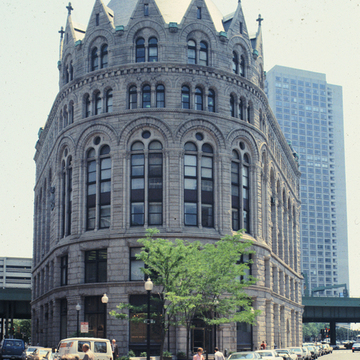You are here
Chamber of Commerce Building (Flour and Grain Exchange Building)
After the death of H. H. Richardson in April 1886, several of his draftsmen formed the successor firm of Shepley, Rutan and Coolidge. Rarely is there difficulty in recognizing the difference between the two firms, but the Chamber of Commerce Building offers an exception. The design is clearly based on Richardson's warehouse for the Ames family that was built on Kingston Street in 1882 and burned in 1889. Both buildings were constructed of granite in the Romanesque style to occupy a corner lot, which allowed for a dramatic rounded facade. Although a comparison of the two buildings illustrates Richardson's more imaginative handling of the style, the Chamber of Commerce Building stands on its own as a powerful example of Richardsonian Romanesque architecture. It was constructed of pink Worcester Quarry granite from Milford by Richardson's great contractor, Norcross Brothers. The quarry-faced stone and Romanesque style of the building provides a striking contrast to the more traditional classical and Renaissance-inspired buildings in the Custom House District. Its visual impact has only been enhanced by the removal of the elevated Central Artery, which nearly destroyed the building thirty years ago.
Writing Credits
If SAH Archipedia has been useful to you, please consider supporting it.
SAH Archipedia tells the story of the United States through its buildings, landscapes, and cities. This freely available resource empowers the public with authoritative knowledge that deepens their understanding and appreciation of the built environment. But the Society of Architectural Historians, which created SAH Archipedia with University of Virginia Press, needs your support to maintain the high-caliber research, writing, photography, cartography, editing, design, and programming that make SAH Archipedia a trusted online resource available to all who value the history of place, heritage tourism, and learning.


